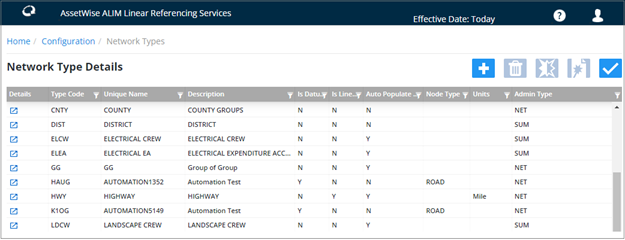Network Types
AWLRS can handle different types and numbers of Networks, or Linear Referencing Systems. This could include, for example, Road, Rail, Ferries, Drainage, Rights of Way, Pipelines, and Utility Networks. Many Road Transportation agencies may use one Network type for Primary and one Network type for secondary roads. Such users are then free to expand the system and use Network Manager to maintain other networks they require such as Rail, Drainage and electrical.
The ‘basic’ Network Type will be flagged as being a ‘Datum’. Network Elements of this type must have a Start Node and End Node and a Length associated with them. Datum Network types will also be flagged as being ‘Linear’. This Linear datum concept underpins the Linear Referencing System and allows for Multiple Linear Referencing methods. This datum will provide direction and connectivity to enable Network Manager to derive each of the linear referencing methods required. The user can then assign Linear Referencing Methods as views or layers on this datum. In North America, for example, this will allow a LRS to be developed that conforms to the NCHRP 20-27 model. In the UK, this allows for the storage and manipulation of National Street Gazetteer (NSG) data.
Using the flexible attribution available within the ‘Type Columns’ window can cater for different naming conventions for different Network Types. These Network Type names may be free text entries or may be derived, based on, for example, ownership and route membership or from other Network Attributes using standard Oracle formatting function calls. Unique values for Element Attributes (Data Type Number) may also be generated automatically from internal system ‘sequences’.
Each Network Type may have a property of Inclusion. This is the Inheritance of Group membership based on the association of a member with the ‘parent’ group via a common network Attribute, Unique Name, Admin Unit etc.
Multiple Type Inclusions are also permitted whereby a Network Element, or Group may be automatically included in more than one ‘parent’ Group.
When a Network Type Inclusion is applied to a Datum Network Type, any Network Elements of the Network Type will be automatically included as members of its parent group(s). If the ‘parent’ group is a Linear Group, connectivity rules will be used to derive the Elemental offsets along the Route.
Network Type Inclusions may also be defined for Network Types associated with Network Groups, whereby a Group is automatically added as a member of another Network Group, thus forming a Group of Groups.
If when creating a new Network Element or Group that has a ‘parent’ Type Inclusion defined, the ‘parent’ group does not already exist, it may be created automatically by the system if the ‘Auto-Create’ checkbox on the ‘Type Inclusion’ panel is selected for the appropriate Network Type inclusion.
The parent network type and ‘parent/foreign’ keys used to establish the network association are defined using the ‘Type Inclusion’ window.
Each Network Type may be sub-defined by adding a Network Type Subclass. These Subclasses may be used as part of the Network Type naming convention and in establishing the connectivity along the ‘parent’ route group. For example, a Road Network Type of ‘Classified Roads’ may have Network Type Subclasses of ‘Single’, ‘Left’ and ‘Right’. This would define whether a Network Element of this type was a Single carriageway, the Left side of a dual carriageway or the Right side of a dual carriageway. Network Type Subclasses are set up using the ‘Type Subclass’ window.
Network Types may be added for use when creating new Network Element Group Types which have differing naming conventions, Units of measurement or in the case of non-linear groups, have no unit of measurement e.g., a group based on a geographical region.
Network Types associated with Group Types may have a Node Type associated with them. This allows for the Start and End Nodes of a Route to be added which could later be used for schematic plans etc.

